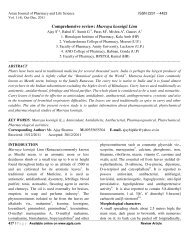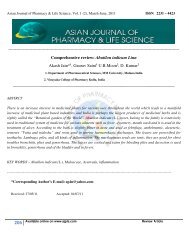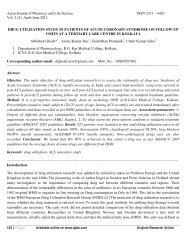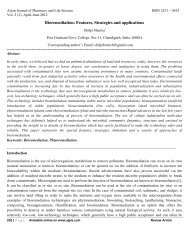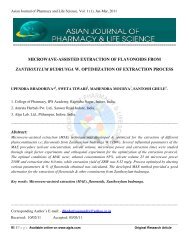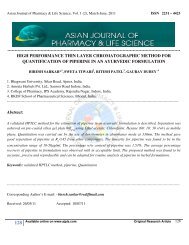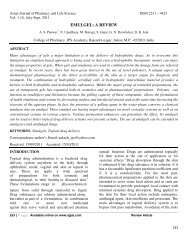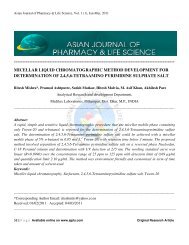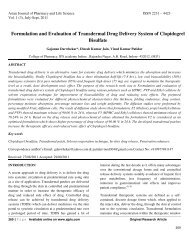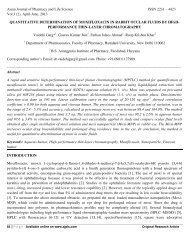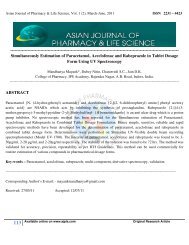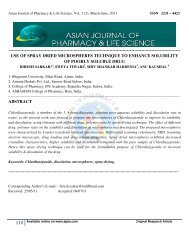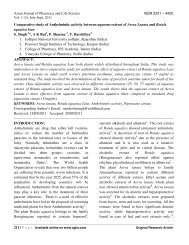Dissolution rate enhancement of aceclofenac by solid dispersion ...
Dissolution rate enhancement of aceclofenac by solid dispersion ...
Dissolution rate enhancement of aceclofenac by solid dispersion ...
Create successful ePaper yourself
Turn your PDF publications into a flip-book with our unique Google optimized e-Paper software.
Asian Journal <strong>of</strong> Pharmacy and Life Science ISSN 2231 – 4423<br />
Vol. 1 (4), Oct-Dec, 2011<br />
various methods for preparing <strong>solid</strong> <strong>dispersion</strong> which<br />
includes solvent wetting method, physical mixture,<br />
solvent evaporation method, melting method, solvent<br />
wetting method, fusion method, kneading method and<br />
super critical fluid method, etc [16- 19].<br />
MATERIALS AND METHODS<br />
Materials<br />
Acecl<strong>of</strong>enac was <strong>of</strong> pharmaceutical grade sample,<br />
gifted from Cipla Ltd, Mumbai, India. Lactose and<br />
corn starch were purchased from SD Fine Chemicals<br />
Ltd, Mumbai, India. All solvents were <strong>of</strong> analytical<br />
grade and were used without further purification.<br />
Methods<br />
Preparation <strong>of</strong> <strong>solid</strong> <strong>dispersion</strong>s<br />
a) Preparation <strong>by</strong> physical mixture method<br />
The ratio <strong>of</strong> drug: mixed excipient system was kept<br />
constant (1:1 w/w) in all formulations. Physical<br />
mixtures <strong>of</strong> acecl<strong>of</strong>enac with mixed excipient system<br />
including lactose and corn starch were prepared <strong>by</strong><br />
mixing accu<strong>rate</strong>ly the weighed amount <strong>of</strong> drug and<br />
carrier with the help <strong>of</strong> a spatula in a glass mortar.<br />
b) Preparation <strong>by</strong> solvent wetting method<br />
The required amount <strong>of</strong> acecl<strong>of</strong>enac was dissolved in<br />
an appropriate amount <strong>of</strong> isopropyl alcohol. This<br />
solution was dropped onto mixed excipient system<br />
placed in mortar and was constantly stirred. Finally<br />
the solvent was removed <strong>by</strong> evaporation at room<br />
temperature. The powder so obtained was ground in a<br />
mortar and stored in desiccators.<br />
Various ratios <strong>of</strong> lactose and corn starch used for<br />
preparation <strong>of</strong> <strong>solid</strong> <strong>dispersion</strong><br />
Physical mixture method<br />
1:0.5 ratio <strong>of</strong> lactose and corn starch (F1)<br />
0.5:1 ratio <strong>of</strong> lactose and corn starch (F2)<br />
1:1 ratio <strong>of</strong> lactose and corn starch (F3)<br />
Solvent wetting method<br />
1:0.5 ratio <strong>of</strong> lactose and corn starch (F4)<br />
0.5:1 ratio <strong>of</strong> lactose and corn starch (F5)<br />
1:1 ratio <strong>of</strong> lactose and corn starch (F6)<br />
EVALUATION PARAMETERS<br />
Determination <strong>of</strong> % practical yield<br />
Determination <strong>of</strong> practical yield is useful to determine<br />
the efficiency <strong>of</strong> a preparation technique. The<br />
practical yield is calculated <strong>by</strong> using following<br />
equation:<br />
% Practical yield (%) =<br />
(Weight <strong>of</strong> prepared <strong>solid</strong> <strong>dispersion</strong>s × 100)<br />
Theoretical weight<br />
Estimation <strong>of</strong> drug content<br />
Dissolve <strong>solid</strong> <strong>dispersion</strong>s (equivalent to 100 mg <strong>of</strong><br />
drug) in 100 ml <strong>of</strong> methanol. The solution was<br />
filtered, diluted suitably and analyzed at 275 nm <strong>by</strong><br />
employing UV spectrophotometer. The drug content<br />
is calculated <strong>by</strong> following formula:<br />
Percent drug content =<br />
(Acecl<strong>of</strong>enac amount in weighed quantity <strong>of</strong> <strong>solid</strong> <strong>dispersion</strong>s x 100)<br />
Theoretical amount <strong>of</strong> drug in <strong>solid</strong> <strong>dispersion</strong><br />
PHYSICAL CHARACTERIZATION OF SOLID<br />
DISPERSIONS<br />
Micromeritic study<br />
Determination <strong>of</strong> apparent bulk density:<br />
The powder blend was weighed first and then placed<br />
in a graduated cylinder and measure the volume <strong>of</strong> it.<br />
This gives the relationship to find out the apparent<br />
bulk density (g/ml).<br />
Apparent bulk density = Weight <strong>of</strong> powder blend<br />
Volume <strong>of</strong> powder blend<br />
Determination <strong>of</strong> tapped density:<br />
Tapped density was measured for each batch using<br />
Tap Density Tester (USP) (Electro lab Etd-1020). The<br />
pre-weighed amount <strong>of</strong> powder blend was placed in a<br />
graduated cylinder and tapped for fixed number <strong>of</strong><br />
taps (around 100) on mechanical tapping apparatus.<br />
397 | P a g e Available online on www.ajpls.com Original Research Article



